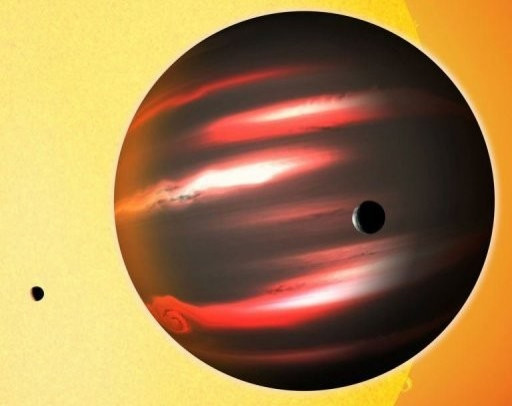Astronomers Discover Darkest Planet, Blacker Than Coal

Astronomers have discovered the darkest known exoplanet, which is a distant, Jupiter-sized gas giant called TrES-2b, in our home galaxy, with NASA's Kepler space telescope.
Their research has been accepted for publication in the Monthly Notices of the Royal Astronomical Society and is available online.
According to their measurements, TrES-2b reflects less than one percent of the sunlight falling on it, making it blacker than coal or any planet or moon in our solar system, according to a press release from the Center for Astrophysics, or CfA.
"TrES-2b is considerably less reflective than black acrylic paint, so it's truly an alien world," said astronomer David Kipping of the Harvard-Smithsonian Center for Astrophysics (CfA), lead author on the paper, in a statement.
Jupiter is enveloped in bright clouds of ammonia that reflect more than a third of the sunlight reaching it. Unlike Jupiter, TrES-2b, which was discovered in 2006 by the Trans-Atlantic Exoplanet Survey, or TrES, lacks reflective clouds because of its high temperature, said CfA.
The darkest planet orbits its star at a distance of three million miles and the star's intense light heats TrES-2b to a temperature of more than 1,800° Fahrenheit, which is much too hot for ammonia clouds, astronomers found.
So instead, its exotic atmosphere comprises light-absorbing chemicals like vaporized sodium and potassium, or gaseous titanium oxide, CfA said, yet none of these chemicals fully explain the extreme blackness of TrES-2b.
"It's not clear what is responsible for making this planet so extraordinarily dark," said co-author David Spiegel of Princeton University, also in a statement. "However, it's not completely pitch black. It's so hot that it emits a faint red glow, much like a burning ember or the coils on an electric stove."
CfA said Kipping and Spiegel were able to determine the reflectivity of TrES-2b by using data from NASA's Kepler spacecraft. Kepler is designed to precisely measure the brightness of distant stars.
The team monitored the brightness of the TrES-2 system as the planet orbited its star and they detected a subtle dimming and brightening because of the planet's changing phase.
Astronomers believe that TrES-2b is tidally locked like our moon, so one side of the planet always faces the star. Like our moon, the planet shows changing phases as it orbits its star and this causes the total brightness of the star plus planet to vary slightly, CfA said.
"By combining the impressive precision from Kepler with observations of over 50 orbits, we detected the smallest-ever change in brightness from an exoplanet: just six parts per million," Kipping said. "In other words, Kepler was able to directly detect visible light coming from the planet itself."
© Copyright IBTimes 2024. All rights reserved.






















